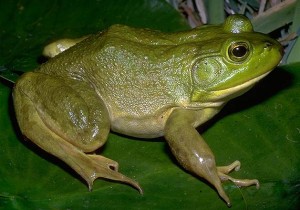American Bullfrog
Photo Credit:https://en.wikipedia.org/wiki/File:Bullfrog_-_natures_pics.jpg
The back of the bullfrog is olive-green, sometimes with grayish-brown mottling. Its green upper lip is distinctive from its pale lower lip.
The eyes have brown irises and horizontal elliptical shaped pupils. The large eardrums (tympani) are located behind the eyes and conspicuous for their size. The front limbs are short with un-webbed hands. The strong longer back legs have webbing between the digits except for the fourth toe.
Male bullfrogs aggregate into groups called choruses. External fertilization occurs when the female’s batch of eggs and the male’s sperm are released simultaneously in shallow water among vegetation. The embryos hatch in 3-5 days. In water temperatures above 90°F, developmental abnormalities result. Normal development is interrupted at temperatures below 59 °F. Newly hatched tadpoles have three pairs of external gills. Water flowing through the gills carries bacteria, single-celled algae and protozoa that become trapped in a filtration organ in their pharanges. Mature bullfrogs can eat invertebrates, crayfish, snails and insects. Their mucous-coated tongue can be rapidly extended to attach to an insect or other prey. The tongue is then rapidly retracted back into its mouth.
American Bullfrog photo by Jim Harding visit http://www.fcps.edu/islandcreekes/ecology/bullfrog.htm
Visit the Kansas Herpetofaunal Atlas for a bullfrog recording http://web.fhsu.edu/ksfauna/herps/index.asp?page=species&species_id=515-849&dots=yes&tributaries=yes&isAnura=&map=ks.

